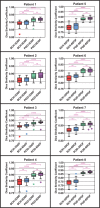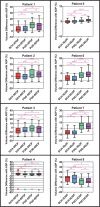Empirical analysis of a plan-of-the-day strategy to approximate daily online reoptimization for prostate CBCT-guided adaptive radiotherapy
- PMID: 38029380
- PMCID: PMC10795443
- DOI: 10.1002/acm2.14221
Empirical analysis of a plan-of-the-day strategy to approximate daily online reoptimization for prostate CBCT-guided adaptive radiotherapy
Abstract
Purpose: Adaptive radiotherapy (ART) can improve the dose delivered to the patient in the presence of anatomic variations. However, the required time, effort, and clinical resources are intensive. This work analyzed a plan-of-the-day (POD) approach on clinical patients treated with online ART to explore implementations that balance dosimetric benefit and clinical resource cost.
Methods: Eight patients treated to the prostate and proximal seminal vesicles with 26 fractions of CBCT-guided, daily online ART were retrospectively analyzed. With a plan library composed of daily adaptive plans from the initial week of treatment and the original plan, the effect of a POD approach starting the following week was investigated by simulating use of these previously generated plans under 3- and 6-degree-of-freedom patient alignment. The plan selected for each treatment was that from the library that maximized the Dice similarity coefficient of the clinical target volume with that of the current treatment fraction. The resulting distribution of several target coverage and organ-at-risk dose metrics are described relative to those achieved with the daily online reoptimized adaptive technique.
Results: The values of target coverage and organ-at-risk dose metrics varied across patients and metrics. The POD schemas closely approximated the reference values from a fully reoptimized adaptive plan yet required less than 20% of the reoptimization effort. The POD schemas also had a much greater effect on target coverage metrics than 6-degree-of-freedom registration did. Organ-at-risk dose metrics also varied considerably across patients but did not exhibit a consistent dependence on the particular schema.
Conclusions: POD schemas were able to achieve the vast majority of the dosimetric benefit of daily online ART with a small fraction of the online reoptimization effort. Strategies like this might allow for more practical and strategic implementation of ART so as to benefit a greater number of patients.
Keywords: ART; CBCT-guided ART; adaptive radiotherapy; online ART; plan-of-the-day.
© 2023 The Authors. Journal of Applied Clinical Medical Physics published by Wiley Periodicals, LLC on behalf of The American Association of Physicists in Medicine.
Conflict of interest statement
A.D.Y. reports a patent regarding an adaptive radiotherapy phantom.
Figures




References
MeSH terms
LinkOut - more resources
Full Text Sources

